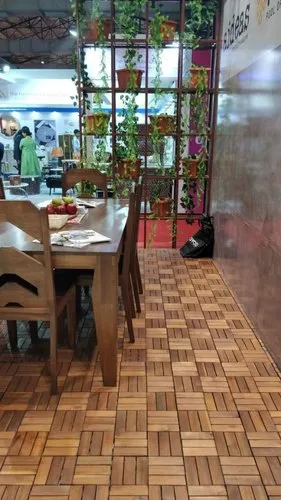Borneo Teak Deck Flooring Tile, Thickness: 20-25 mm
₹275.0
Product Specification
| Thickness | 20-25 mm |
| Color | Teak |
| Coverage Area | 1 x 1 Feet |
| Deck Flooring Area | Home |
| Decking Type | Tile Interlocking |
| Minimum Order Quantity | 100 Square Feet |
Product Description
- As an esteemed organization of this domain, we are engrossed in presenting a broad spectrum of Outdoor Deck Flooring.
- Offered by us in numerous patterns, designs and combinations; these offered Outdoor Deck Wooden Flooring that is widely appreciated by the customers due to their reliability, abrasion resistance, dimensional accuracy and sophisticated look.
- Our offered outdoor deck flooring is manufactured using high-grade wood along with imported plastic to assure water resistance.
DESCRIPTION
- Our range of Deck Flooring is made of IPE, Lunawood, Teak Wood, WPC, etc. and is designed in such a way that it creates a non-slippery surface with a solid grip.
- These are mainly used for wet surroundings like swimming pools, gardens and parks.
- These are also commonly used for the walkways and jogging tracks.
- We ensure that the offered services are executed with the help of advanced technology and machines.
- Also, our professionals are capable of rendering these services as per clients’ exact specifications.
- We have equipped our professionals with latest tools and machines so that the services offered to clients are timely completed.
- Also, our professionals understand each and every requirement of clients and provide designs as per the ambiance and environment at clients; site.
- Offered at market leading prices, these services are extensively demanded in market.
FEATURES
- Non-slippery
- Waterproof
- Rot-proof
- Easy to install
- No vibration noise
- Low maintenance
- Resistant to impacts and breaking
- Attractive
- Durable
- Fine finish
- Termite proof
- Weather resistant
APPLICATION
- Pools
- Resorts
- Farm House
- Landscape
- Pergola floor
- Geometric pools
- Public Gardens
- House Courtyard and backyard
- Description
- Additional information
- Reviews (0)
- Q & A
- Sustainability Remark
- More Offers
- Store Policies
- Inquiries
| Color | Teak |
|---|
You must be logged in to post a review.
Q & A
Low VOC Flooring:
Low VOC (Volatile Organic Compound) flooring is a sustainable flooring option that has gained popularity due to its environmental benefits. VOCs are chemicals that can be emitted as gases from certain solids or liquids, including many traditional flooring materials. These chemicals can have harmful effects on indoor air quality and contribute to air pollution.
Low VOC flooring products are designed to have minimal VOC emissions, making them safer for indoor environments and promoting better air quality. These flooring options are typically made from natural or recycled materials and are manufactured using environmentally friendly processes. Common types of low VOC flooring include bamboo, cork, linoleum, and certain types of engineered wood or laminate flooring.
The sustainability of low VOC flooring depends on various factors:
Material sourcing: Look for flooring options that use sustainably sourced materials. For example, bamboo flooring can be sustainable if harvested from well-managed bamboo forests.
Manufacturing process: Choose flooring products that are manufactured using energy-efficient processes and have minimal environmental impact. Some manufacturers prioritize using renewable energy sources and reducing water and energy consumption during production.
Durability: Opt for flooring that is durable and long-lasting. This reduces the need for frequent replacement and minimizes waste generation.
Recyclability: Consider flooring options that can be recycled or repurposed at the end of their life cycle. This helps divert waste from landfills and reduces the demand for new materials.
Water-Efficient Plumbing:
Water-efficient plumbing systems are essential for conserving water, reducing water waste, and promoting sustainability. These systems aim to minimize water usage without compromising functionality or user experience. Here are some key components and practices of water-efficient plumbing:
Low-flow fixtures: Install low-flow showerheads, faucets, and toilets that use less water compared to traditional fixtures. For example, low-flow showerheads can reduce water consumption by mixing air with water to maintain water pressure while reducing flow rates.
Dual-flush toilets: Consider using dual-flush toilets that offer two flushing options—full flush and half flush. This allows users to select the appropriate water volume based on their needs, resulting in significant water savings.
Greywater systems: Implement greywater recycling systems to capture and treat wastewater from sources like sinks, showers, and laundry. Treated greywater can be reused for irrigation or flushing toilets, reducing the demand for freshwater.
Leak detection and repair: Regularly inspect plumbing systems for leaks and promptly repair them. Even minor leaks can waste significant amounts of water over time.
Smart irrigation: Install smart irrigation systems that use weather data and soil moisture sensors to optimize watering schedules and prevent overwatering. This ensures efficient water usage in landscaping and reduces unnecessary water consumption.
To ensure the sustainability of water-efficient plumbing, it is important to combine these measures with user education and responsible water management practices. Regular maintenance, monitoring water usage, and promoting water-saving habits among occupants are crucial for long-term effectiveness.
General Inquiries
There are no inquiries yet.




















Reviews
There are no reviews yet.